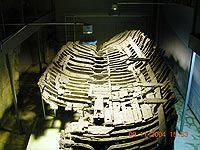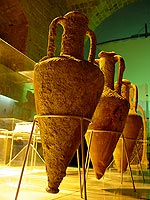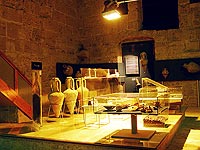
The Shipwreck Museum in Kyrenia, North Cyprus.
 |
the north cyprus travel guide |
 |
|
The Shipwreck Museum
The Shipwreck Museum, is housed in the Gothic halls of Kyrenia Castle. The Shipwreck Museum houses one of the most remarkable marine archaeological finds in the world. Sailing to North Cyprus – in 288BCAround 288BC, a trading vessel, laden with millstones and amphorae (large jars) of wine from Kos and Rhodes set sail for Cyprus. The ship was caught in a storm, and was wrecked outside Kyrenia harbour. The remains of the ship sat on the seabed covered in sand for 2300 years until discovered by a sponge diver in 1965. A team of marine archaeologists from the University of Pennsylvania surveyed the site of the wreck, which measured sixty feet by thirty feet. During 1968 and 1969, the team brought the remains of both ship and cargo to the surface in pieces, a delicate operation to recover what was then the oldest discovered ship in the world. It would take another six years to reconstruct the wreck as it appears today. The ship itself was already around 80 years old when it sank, and had been repaired several times, including having a skin of lead applied to the outside to keep it watertight. The Contents of the Kyrenia Shipwreck, North Cyprus
The 47ft long hull, made of Aleppo (or Jerusalem) pine covered in lead, is preserved in a specially controlled environment in the Museum. Over 400 wine jars, or amphorae, were also recovered, possibly from the Greek island of Rhodes. In the keel were rows of basalt mill stones from the island of Kos, cargo that was also used as ballast. The marine archaeologists also discovered 9000 almonds, which were part of the rations for the crew. Since nearly every domestic item found were in groups of four; four cups, four wooden spoons, four oil jugs, there were more likely to be four men in the crew. The crew would have caught and eaten fish, as 300 lead fishing net weights were also discovered in the bow of the wreck. Viewing the shipwreck in the Museum at Kyrenia Castle, North CyprusThe upper level of the Museum shows photographs of the recovery process. You can then walk out on a platform over the wreck itself, soaked in preservatives and kept in low light conditions to preserve it for future generations. The Shipwreck Museum is a fascinating insight into life in North Cyprus and the Mediterranean in the third century BC.
|
|
North Cyprus quick: holidays | flights | hotels | property | kyrenia | famagusta | photos | map | weather | history | news
All text is copyrighted by Cyprus44. Photographs are copyrighted by their respective photographers.
For more information read our copyright policy, privacy policy and disclaimer.
This web page is served on 17 September 2025 at 1:20:43 AM.
![]()
Cyprus44 in other languages: Nordzypern | Chypre Nord | Severní Kypr | Северный Кипр
partner sites: goNorthCyprus Travel | Pacific Rent-A-Car | Amy Holiday Villas | other partner sites










